#INCLUDING A NEW ONE THEY PIONEERED!
Explore tagged Tumblr posts
Photo

Wendy Carlos pictured with the Moog System 55 a staple in her solo projects and iconic film scores, including for Stanley Kubrick's 'A Clockwork Orange' (1972)
One of electronic music's most important figures, Wendy Carlos is a true pioneer of the craft with countless influential albums and scores. She provided technical advice and insights to Robert Moog during the development of the Moog Synthesizer, an instrument that would revolutionize the music landscape. Her album 'Sonic Seasonings' (1972) is an early example of an ambient record, blending the then-new synth with field recordings to create an entirely new listening experience — years before the term "ambient" was even coined!
#wendy carlos#moog#moog system 55#synthesizer#synths#robert moog#score#albums#electronic#electronic music#ambient#sonic seasonings#music#stanley kubri#a clockwork orange#sound#musician#artist#u
15K notes
·
View notes
Text
The Best News of Last Year - 2023 Edition
Welcome to our special edition newsletter recapping the best news from the past year. I've picked one highlight from each month to give you a snapshot of 2023. No frills, just straightforward news that mattered. Let's relive the good stuff that made our year shine.
January - London: Girl with incurable cancer recovers after pioneering treatment

A girl’s incurable cancer has been cleared from her body after what scientists have described as the most sophisticated cell engineering to date.
2. February - Utah legislature unanimously passes ban on LGBTQ conversion therapy

The Utah State Legislature has unanimously approved a bill that enshrines into law a ban on LGBTQ conversion therapy.
3. March - First vaccine for honeybees could save billions

The United States Department of Agriculture (USDA) has approved the world’s first-ever vaccine intended to address the global decline of honeybees. It will help protect honeybees from American foulbrood, a contagious bacterial disease which can destroy entire colonies.
4. April - Fungi discovered that can eat plastic in just 140 days

Australian scientists have successfully used backyard mould to break down one of the world's most stubborn plastics — a discovery they hope could ease the burden of the global recycling crisis within years.
5. May - Ocean Cleanup removes 200,000th kilogram of plastic from the Pacific Ocean

The Dutch offshore restoration project, Ocean Cleanup, says it has reached a milestone. The organization's plastic catching efforts have now fished more than 200,000 kilograms of plastic out of the Pacific Ocean, Ocean Cleanup said on Twitter.
6. June - U.S. judge blocks Florida ban on care for trans minors in narrow ruling, says ‘gender identity is real’

A federal judge temporarily blocked portions of a new Florida law that bans transgender minors from receiving puberty blockers, ruling Tuesday that the state has no rational basis for denying patients treatment.
7. July - World’s largest Phosphate deposit discovered in Norway

A massive underground deposit of high-grade phosphate rock in Norway, pitched as the world’s largest, is big enough to satisfy world demand for fertilisers, solar panels and electric car batteries over the next 50 years, according to the company exploiting the resource.
8. August - Successful room temperature ambient-pressure magnetic levitation of LK-99

If the claim by Sukbae Lee and Ji-Hoon Kim of South Korea’s Quantum Energy Research Centre holds up, the material could usher in all sorts of technological marvels, such as levitating vehicles and perfectly efficient electrical grids.
9. September - World’s 1st drug to regrow teeth enters clinical trials

The ability to regrow your own teeth could be just around the corner. A team of scientists, led by a Japanese pharmaceutical startup, are getting set to start human trials on a new drug that has successfully grown new teeth in animal test subjects.
10. October - Nobel Prize goes to scientists behind mRNA Covid vaccines

The Nobel Prize in Physiology or Medicine has been awarded to a pair of scientists who developed the technology that led to the mRNA Covid vaccines. Professors Katalin Kariko and Drew Weissman will share the prize.
11. November - No cases of cancer caused by HPV in Norwegian 25-year olds, the first cohort to be mass vaccinated for HPV.
Last year there were zero cases of cervical cancer in the group that was vaccinated in 2009 against the HPV virus, which can cause the cancer in women.
12. December - President Biden announces he’s pardoning all convictions of federal marijuana possession

President Joe Biden announced Friday he's issuing a federal pardon to every American who has used marijuana in the past, including those who were never arrested or prosecuted.
------
And there you have it – a year's worth of uplifting news! I hope these positive stories brought a bit of joy to your inbox. As I wrap up this special edition, I want to thank all my supporters!
Buy me a coffee ❤️
Merry Christmas and Happy New Year!
6K notes
·
View notes
Text
midheaven.

─ ཐི ⋅ ♰ ⋅ ཋྀ ─
the midheaven represents one's career, legacy, and public image. it also showcases details towards our achievements, the persona we withhold, and the type of careers we often find ourselves drawn to. it's located in the tenth house cusp which highlights core themes that are related to hard work, discipline, and challenges. it is directly opposite from the imum coeli which represents how one's desires or needs appears to be within their private home and domestic life.
⁺₊ ʚ aries
native is known for their pioneering spirit within the public eye as they are a natural-born leader with a strong ambition to accomplish their goals. independence is something that comes naturally to them and they prefer to work alone on their own accord at a quick pace. they may not be receptive towards having to receive orders from others, which could cause conflict within the workforce if they work with other people. they can be competitive individuals with an intense desire to succeed and are able to adapt to their work at a resilient pace due to their strong work ethic. they are easily able to possess a natural authoritative nature that can grant them multiple opportunities to rise towards higher positions in their career and even lead one of their own. it's important that these natives take upon leadership roles that will fuel growth in their career and inspire others in some way. they are likely to thrive in a career that ignite a deep passion and encourage them to take charge as their own individual boss.
⁺₊ ʚ taurus
native is known for their hard work within the public eye as they are persistent to achieve their goals. for them, through their work to enjoy the finer things life has to offer. they are drawn towards work that inspires their creativity and fulfills their pleasure towards luxury and beauty. they are likely to have a steady, slow approach towards building a career. they are very determined to succeed but may also be susceptible towards burnout or laziness if they are not motivated. with a refined taste for aesthetics, they relish partaking in work that inspires them to use their knack of knowledge related to art and beauty where they can showcase it to others. they can create and maintain a sufficient amount of income through various creative ways, including those that does not require much effort to do so. it's important that these natives create foundations that offers them a strong, evergrowing flow of income that'll provide security in their life. they are likely to thrive in a career that offers them stability and long-term financial growth that are able to last for future generations.
⁺₊ ʚ gemini
native is known for their excelled communication within the public eye as they are very skilled at expressing their own thoughts and ideas with others. their effective social skills allows them to effortlessly network and connect with other people. they easily cultivate strong connections that can be of great benefit to them in the long run and have a quick wit that grants them the ability to solve complex problems with very unique solutions. they enjoy being mentally stimulated with work that requires them to think outside of the box and are likely to delve into a series of research that grants them more knowledge. they are quite curious and enjoy learning new things that challenges them to further expand on their own intellect. if there is too much unfocused energy, there could be a sense of indecisiveness within their career. it's important that they take any distracted energies they may withold and transfer them into productive projects that will provide them prosperity with their work. they are likely to thrive in a career that encourages them to showcase their intellective and creative ideas or concepts with other people.
⁺₊ ʚ cancer
native is known for their empathetic approach within the public eye as they are intuitive and can easily pick up on the emotions of those whom are in their environments. they are protective over the people they care about and are likely to keep their home or private life hidden from the spotlight. if underdeveloped, they can come off as overly controlling or possessive towards their loved ones. they desire emotional fulfillment within their work, which can definitely be lead as the driving force in their career. there is an emphasis on how emotions and stability is a staple piece for how they decide to show up in their work. they may have experienced hidden anxiety due to an overwhelming pressure when it comes to taking on far more than they can handle. their compassion can become their demise if there's failure to check in every now and then on their own well-being. it's important that these natives feel emotionally safe when it comes to their work. they are likely to thrive in a career where they can use their empathy and intuition to contribute to those in need.
⁺₊ ʚ leo
native is known for their confidence within the public eye as they inspire others with their work. they are deeply ambitious with a willingness to put in much work to become successful in their careers. they are clever and inventive with the way they create their work, which often captures many people's attention. they don't often shy away from challenges that are presented to them and face them instead with true courage. their commitment is one of their greatest advantages that lets them overcome hurdles, which also inspires people to do the same as well. there could be one-sided competition from competitors who are jealous towards the amount of positive attention they receive from others. too much self-indulgence could also occur if they happen to become overly obsessive with having the spotlight. it's important that these natives maintain a balance between their desire to be recognized and their desire to fully express themselves in creative ways that showcases their truest self. they are likely to thrive in a career that allows them to incorporate inventive concepts into their creative pursuits that is able to inspire the masses.
⁺₊ ʚ virgo
native is known for their diligence within the public eye as they acquire a keen attention to details that can be used to solve complex problems. they are very committed towards their work and put in a lot of effort to perfect them. they are extremely intelligent and enjoy learning new things can be applied, especially if it can help improve the lives of others. they are likely to create methodical steps that allows them to pursue their goals in an efficient way, and their practical and analytical approach allows them to maintain a steady focus on their tasks with no distraction. their hard work can lead to them mastering their career and obtaining achievements in the long term through determined efforts. perfectionism can result in over-criticism towards themselves and their work, which can deter their focus from accomplishing goals at a sufficient pace. it's important that these natives understand that perfection is not necessary when it comes their work, true authenticity is what makes art complete. they are likely to thive in a career that require them to use their logic and critical thinking to help people improve in their own lives.

⁺₊ ʚ libra
native is known for their diplomacy within the public eye as they seek to maintain fairness amongst people. they are a diplomat who likes to immerse themselves in the different viewpoints and perspectives that people have because it allows them to gain a broader comprehension of the way others think. their capacity to understand differed opinions and beliefs of others makes it easy for them to bring groups of people together, which can be a great source of healing for many. being surrounded by aesthetics that are pleasing to the eye could inspire them to delve into innovative ideas where they make art of their own. their sociable nature can come with some negative effects, potential people pleasing tendencies could result in them being taken advantage of by those with negative intentions. they need to ensure there's a steady balance between their desire to connect with others while making sure they do not fall victim. it's important that these natives utilize their natural charm and social skills to create art amongst bringing people together. they are likely to thrive in a career that encourages them to delve into the creative arts or maintain harmony amongst the collective.
⁺₊ ʚ scorpio
native is known for their transformation within the public eye as they've faced much changes that have showed drastic impacts in their career. they are a mysterious enigma who's quite secretive when it comes to discussing their private life that goes on behind the scenes. they are independent and could care less for authority or being told what to do. they're either extremely loved or hated by people, and many strong opinions can be based off of their mere existence alone. they feel most alive when they're chasing after goals that grants them some kind of profound transformation in their own life. passion runs in their veins and these individuals will stop at nothing to achieve their desires. although their intense drive can be of great benefit to them, it can also lead to excessive burnout once they finally master whatever they were chasing after to begin with. it's important that these natives partake in work that inspires them to undergo deep metamorphosis related to the complex aspects that human existence has to offer. they are likely to thrive in a career that involves death, transformation, and uncovering utmost dark hidden truths.
⁺₊ ʚ sagittarius
native is known for their expansiveness within the public eye, as they crave gaining knowledge that they are able to share with others. they are very optimistic and withold enthusiasm towards learning more about the world around them. their versatility can provide them with multiple opportunities to cultivate significant success in their career. they often seek much adventure and building connections with people from different cultures. they become dissatisfied if they are in an environment that attempts to restrict their ability to explore or learn from a fresh perspective. they are easily adaptable to situations or spaces that are new to them due to their easily acceptable nature and can meet many people they are able to become closer with over time. their versatility can lead to many triumphs in their careers, but it can also lead to having no particular aim when it comes to finding the right path to pursue. it's important that these natives acquire the wisdom that they've gained through their experiences to educate or even enlighten people who can learn from their information. they are likely to thrive in a career that grants them with the freedom to travel and expand their perspectives about the world where they could share with others and teach them.
⁺₊ ʚ capricorn
native is known for their ambition within the public eye, as they are resilient towards achieving long-term goals. logic, discipline, and structure are potent themes when it relates towards the way they decide to approach their work. their strong ethic makes them very notable individuals who are often acknowledged for their accomplishments due to their precise dedication. they undergo significant growth through their career that can drastically reflect their career status or reputation from the collective. they are competitve and are able to find much strength in powering through challenges or roadblocks they face with courage. taking on a series of different responsibilities comes to them easily because they like to feel a deep sense of responsibility when it comes to their work. although their immense drive can provide much success in their career, it can lead to much losses as well in their connections if they isolate themselves or neglect their loved ones. it's important that these natives establishes a strong sense of duty within their work and become a leader. they are likely to thrive in a career that values discipline and practicality which provides them with long-term success.
⁺₊ ʚ aquarius
native is known for their innovative nature within the public eye, as they showcase groundbreaking ideas that changes the world. they are very innovative and often create unique original ideas that challenges the status quo. the traditional path is not one that they're quite fond of, instead they aspire to create their own that truly aligns within their desires. they are good at problem-solving in a way that may require them to think outside of the box and create fresh, eccentric ideas. people usually find themselves inspired by them due to their distinctive nature when it comes to the way they show up in their work. their originality brings great benefits, but it also brings quite some challenges as well. for instance, they may not mesh well with authority due to clashes when it comes to traditions that challenges their nonconformist beliefs. it's important that these natives challenge progressive concepts that inspires the collective to think on a newfound level. they are likely to thrive in a career that supports originality and making a change or impact in the world in a significant way.
⁺₊ ʚ pisces
native is known for their creativity within the public eye, as they have quite a dreamy-like essence that can be used to tap into their work. they are very imaginative and enjoy the concept of using art to express themselves in a mystical way enchants others. they are compassionate and can be drawn towards fields where they are able to use their intuition to help others in need. they prefer to work alone and on their own time that they desire to do so. they either work at an irregular pace or if they're truly passionate, do so with more efficiency due to having more focus on their work. they are likely to undergo various shifts in their career that changes and reflects their self-growth on a deep transformative level. if they are distracted, they may have a harder time adjusting to a career that fits best for them and can spend quite some time looking for the right fit. it's important that these natives hone their intuitive skills to partake in work which uplifts and services others. they are likely to thrive in a career in which they can express their creativity and positively affect others.

#astrology#dark astrology#western astrology#vedic astrology#astrology tumblr#astrology community#astrology notes#astrology observations#astrology placements#astrology mc#astroblr#astro tumblr#astro community#astro notes#astro observations#astro placements#astro mc#midheaven#zodiac#zodiac signs
910 notes
·
View notes
Text
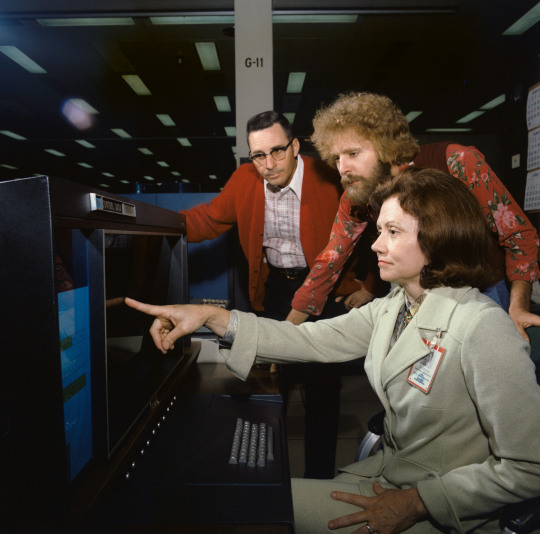
LaRue Burbank, mathematician and computer, is just one of the many women who were instrumental to NASA missions.
4 Little Known Women Who Made Huge Contributions to NASA
Women have always played a significant role at NASA and its predecessor NACA, although for much of the agency’s history, they received neither the praise nor recognition that their contributions deserved. To celebrate Women’s History Month – and properly highlight some of the little-known women-led accomplishments of NASA’s early history – our archivists gathered the stories of four women whose work was critical to NASA’s success and paved the way for future generations.
LaRue Burbank: One of the Women Who Helped Land a Man on the Moon
LaRue Burbank was a trailblazing mathematician at NASA. Hired in 1954 at Langley Memorial Aeronautical Laboratory (now NASA’s Langley Research Center), she, like many other young women at NACA, the predecessor to NASA, had a bachelor's degree in mathematics. But unlike most, she also had a physics degree. For the next four years, she worked as a "human computer," conducting complex data analyses for engineers using calculators, slide rules, and other instruments. After NASA's founding, she continued this vital work for Project Mercury.
In 1962, she transferred to the newly established Manned Spacecraft Center (now NASA’s Johnson Space Center) in Houston, becoming one of the few female professionals and managers there. Her expertise in electronics engineering led her to develop critical display systems used by flight controllers in Mission Control to monitor spacecraft during missions. Her work on the Apollo missions was vital to achieving President Kennedy's goal of landing a man on the Moon.
Eilene Galloway: How NASA became… NASA
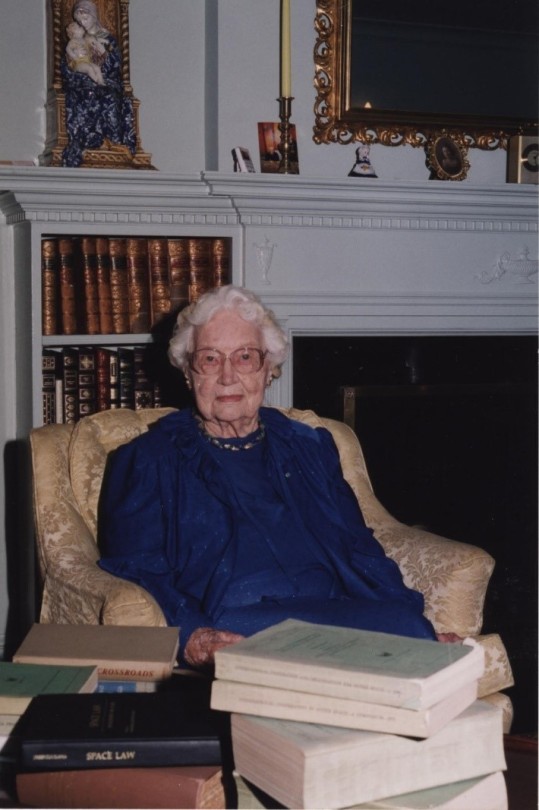
Eilene Galloway wasn't a NASA employee, but she played a huge role in its very creation. In 1957, after the Soviet Union launched Sputnik, Senator Richard Russell Jr. called on Galloway, an expert on the Atomic Energy Act, to write a report on the U.S. response to the space race. Initially, legislators aimed to essentially re-write the Atomic Energy Act to handle the U.S. space goals. However, Galloway argued that the existing military framework wouldn't suffice – a new agency was needed to oversee both military and civilian aspects of space exploration. This included not just defense, but also meteorology, communications, and international cooperation.
Her work on the National Aeronautics and Space Act ensured NASA had the power to accomplish all these goals, without limitations from the Department of Defense or restrictions on international agreements. Galloway is even to thank for the name "National Aeronautics and Space Administration", as initially NASA was to be called “National Aeronautics and Space Agency” which was deemed to not carry enough weight and status for the wide-ranging role that NASA was to fill.
Barbara Scott: The “Star Trek Nerd” Who Led Our Understanding of the Stars
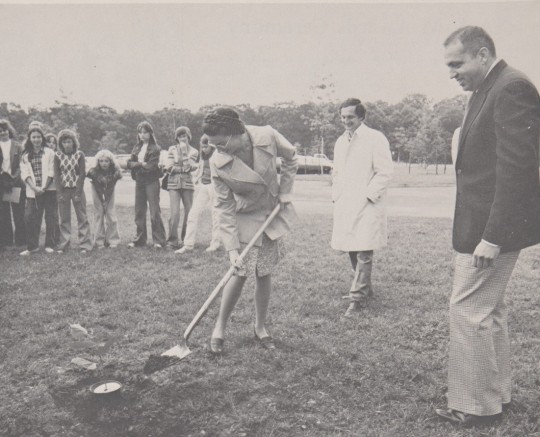
A self-described "Star Trek nerd," Barbara Scott's passion for space wasn't steered toward engineering by her guidance counselor. But that didn't stop her! Fueled by her love of math and computer science, she landed at Goddard Spaceflight Center in 1977. One of the first women working on flight software, Barbara's coding skills became instrumental on missions like the International Ultraviolet Explorer (IUE) and the Thermal Canister Experiment on the Space Shuttle's STS-3. For the final decade of her impressive career, Scott managed the flight software for the iconic Hubble Space Telescope, a testament to her dedication to space exploration.
Dr. Claire Parkinson: An Early Pioneer in Climate Science Whose Work is Still Saving Lives

Dr. Claire Parkinson's love of math blossomed into a passion for climate science. Inspired by the Moon landing, and the fight for civil rights, she pursued a graduate degree in climatology. In 1978, her talents landed her at Goddard, where she continued her research on sea ice modeling. But Parkinson's impact goes beyond theory. She began analyzing satellite data, leading to a groundbreaking discovery: a decline in Arctic sea ice coverage between 1973 and 1987. This critical finding caught the attention of Senator Al Gore, highlighting the urgency of climate change.
Parkinson's leadership extended beyond research. As Project Scientist for the Aqua satellite, she championed making its data freely available. This real-time information has benefitted countless projects, from wildfire management to weather forecasting, even aiding in monitoring the COVID-19 pandemic. Parkinson's dedication to understanding sea ice patterns and the impact of climate change continues to be a valuable resource for our planet.
Make sure to follow us on Tumblr for your regular dose of space!
#NASA#space#tech#technology#womens history month#women in STEM#math#climate science#computer science
2K notes
·
View notes
Text
Neptune in the Signs
paid readings | Masterlist
ᡣ𐭩 Please support me by reposting, liking, following me. Neptune is the planet is illusions and dreams, it represents the mystical and the unconditional. Although no one alive will have neptune in taurus (well i think) thoes descriptions are for the degrees to apply to your life.



0º is the degree which doesn't have a coresponding sign assigned to it. It's a fresh new degree and will amplify the themes of the sign that it's in
Aries (1,13,25º) Neptune in Aries brings a fiery and impulsive energy to dreams and spirituality. Natives with this placement often chase their ideals with fire and guts however they may struggle with impatience or rushing into the oasis. Their intuition drives them forward to be pioneers to new spiritual or creative paths, although they need to watch for self deception fuled by impulsive actions.
Taurus (2, 14, 26°) Dreams are grounded in a sensory experience and bathing in material beauty. This placement can create a deep appreciation for arts, music and nature, inspiring practical creativity and a deep spiritual connection to the phsyical world. On the other hand there can be a tendency towards stubborn illusions or clinging to comfort in escapism.
Gemini (3, 15, 27°) Neptune in Gemini gifts a imaginative mind filled to the brim with fluid communication. These individuals often have a poetic dreamy way with words and ideas blending intellect with intuition. Their spiritual insights may come through convosations, writing and even perhaps teaching; though they can sometimes get lost in scattered thoughts or deceptive information
Cancer (4, 16, 28°) Neptune here blends deep emotional sensitivity with mystical intutitoon. This placement enhances empathy and psychic receptivity, making these natives highly compassionate. They may be even have a spirtual connection to their ancestral or familial history. They may idealize the home and family but should guard against emotional illusions or over-dependance.
Leo (5, 17, 29°) Neptune here blends deep emotional sensitivity with mystical intutitoon. This placement enhances empathy and psychic receptivity, making these natives highly compassionate. They may be even have a spirtual connection to their ancestral or familial history. They may idealize the home and family but should guard against emotional illusions or over-dependance.
Virgo (6, 18° ) Neptune is in fall in virgo and such natives fall into healing people through practical means. Typically what this means is that these natives don’t have as strong/are deconstructing spiritual beliefs. These natives may serve others through healing, analysis and service and are ultimatly guided by intuition and compassion. They may deal with illusions when it comes to purity, and may use escapism to negate their overthinking nature.
Libra (7, 19°) Neptune softens the desire for harmony with dready idealism in relationships. Natives with this placement often envision themselves in ‘perfect love’ or social balance. This includes fields such as art, diplomacy and romantic fantasy. However they can be prone to illusions about others and may be martyrs for situations for when conflict aries.
Scorpio( 8, 20°) This placement delves into the deepest, most hidden dimensions of honesty, truth, and intimacy. The collective ideal is often about revealing profound truths, transforming through intense experiences. A fascination with the unseen or taboo aspects of existence come up to question in these natives lives.
Sagittarius (9, 21°) In sagittarius, neptune takes on an adventurous spirit with a dreamy vision for truth and boundless exploration. Natives with this placement often envision themselves on a perfect quest for a higher wisdom or achieving ultimate freedom. This includes fields such as philosophy and spirituality. These natives are prone to illusions about the absolute truth of nature or the practicality of their grand visions, and may sacrifice tangible opportunities for an unattainable ideal.
Capricorn (10, 22º) Neptune softens Capricorn's realism with a dreamy idealism for structured visions and long-term societal change. Thoes with this placement often envision themselves building 'perfect' institutions or manifesting spiritual ideals into practical forms. This includes areas of large-scale organization, governance, and the embodiment of collective dreams. However they can be prone to illusions about authority and may take one some personal sacrifice to achieve thoes structured ideals.
Aquarius (11, 23°) Neptune tempers Aquarius' innovative thinking with idealistic optimism for the greater good and humanitarian values. Natives who have this placement frequently envision themselves as leaders of revolutionary movements for the greater good or in "perfect" communities. However, sacrifice personal needs in the name of a common goal and are prone to delusions about group dynamics or the immediate effects of their progressive ideas.
Pisces (12, 24°) Being at home, this placement intensifies it’s dreamy idealism for boundless compassion and spiritual unity. Natives with this placment may envision themselves dissolving into a aura and may be more likely to believe in spirituality. This includes fields such as healing and mysticism and selflessn service. However as always they’re very much likely prone to illusions and escapism, perhaps getting lost in the ocean of dreams.

DISCLAIMER: This post is a generalisation and may not resonate. I recommend you get a reading from an astrologer (me). If you want a reading from me check out my sales page.
@astrofaeology private services 2025 all rights reserved
#astr#astrology#astro community#astro notes#astro observations#astroblr#neptune#neptune in the signs#mermaid#etheral
258 notes
·
View notes
Text
I Hate How She Talks About Snow White

"People are making these jokes about ours being the PC Snow White, where it's like, yeah, it is − because it needed that. It's an 85-year-old cartoon, and our version is a refreshing story about a young woman who has a function beyond 'Someday My Prince Will Come. "

Let me tell you a little something's about that "85-year-old cartoon," miss Zegler.
It was the first-ever cel-animated feature-length full-color film. Ever. Ever. EVER. I'm worried that you're not hearing me. This movie was Disney inventing the modern animated film. Spirited Away, Into the Spider-Verse, Tangled, you don't get to have any of these without Snow White and the Seven Dwarfs (1937.)
Speaking of what you wouldn't get without this movie, it includes anime as a genre. Not just in technique (because again, nobody animated more than shorts before this movie) but in style and story. Anime, as it is now, wouldn't exist without Osamu Tezuka, "The God of Manga," who wouldn't have pioneered anime storytelling in the 1940s without having watched and learned from Snow White and the Seven Dwarfs in the 1930s. No "weeb" culture, no Princess Mononoke, no DragonBall Z, no My Hero Academia, no Demonslayer, and no Naruto without this "85-year-old cartoon."
It was praised, not just for its technical marvels, not just for its synchronized craft of sound and action, but primarily and enduringly because people felt like the characters were real. They felt more like they were watching something true to life than they did watching silent, live-action films with real actors and actresses. They couldn't believe that an animated character could make kids wet their pants as she flees, frightened, through the forest, or grown adults cry with grieving Dwarves. Consistently.
Walt Disney Studios was built on this movie. No no; you're not understanding me. Literally, the studio in Burbank, out of which has come legends of this craft of animated filmmaking, was literally built on the incredible, odds-defying, record-breaking profits of just Snow White and the Seven Dwarfs, specifically.
Speaking of record-breaking profits, this movie is the highest-grossing animated film in history. Still. TO THIS DAY. And it was made during the Great Depression.
In fact, it made four times as much money than any other film, in any other genre, released during that time period. It was actually THE highest-grossing film of all time, in any genre, until nothing less than Gone With the Wind, herself, came along to take the throne.
It was the first-ever animated movie to be selected for the National Film Registry. Actually, it was one of the first movies, period, to ever go into the registry at all. You know what else is in the NFR? The original West Side Story, the remake of which is responsible for Rachel Ziegler's widespread fame.
Walt Disney sacrificed for this movie to be invented. Literally, he took out a mortgage on his house and screened the movie to banks for loans to finish paying for it, because everyone from the media to his own wife and brother told him he was crazy to make this movie. And you want to tell me it's just an 85-year-old cartoon that needs the most meaningless of updates, with your tender 8 years in the business?
Speaking of sacrifice, this movie employed over 750 people, and they worked immeasurable hours of overtime, and invented--literally invented--so many new techniques that are still used in filmmaking today, that Walt Disney, in a move that NO OTHER STUDIO IN HOLLYWOOD was doing in the 30's, put this in the opening credits: "My sincere appreciation to the members of my staff whose loyalty and creative endeavor made possible this production." Not the end credits, like movies love to do today as a virtue-signal. The opening credits.
It's legacy endures. Your little "85-year-old cartoon" sold more than 1 million DVD copies upon re-release. Just on its first day. The Beatles quoted Snow White in one of their songs. Legacy directors call it "the greatest film ever made." Everything from Rolling Stones to the American Film Institute call this move one of the most influential masterpieces of our culture. This movie doesn't need anything from anybody. This movie is a cultural juggernaut for America. It's a staple in the art of filmmaking--and art, in general. It is the foundation of the Walt Disney Company, of modern children's media in the West, and of modern adaptations of classical fairy tales in the West. When you think only in the base, low, mean terms of "race" and "progressivism" you start taking things that are actually worlds-away from being in your league to judge, and you relegate them to silly ignorant phrases like "85-year-old cartoon" to explain why what you're doing is somehow better.
Sit down and be humble. Who the heck are you?
#Snow White#Snow White and the seven dwarfs#snow#snow white 1937#snow white and the seven dwarfs 1937#Snow White 2024#Rachel zegler#west side story#poc#Disney#live action Disney hate#animation history#Do not go see this movie. Do not stream this movie.#Anime#anime history
5K notes
·
View notes
Text
Trust me when I tell you that I love my local Mexican restaurant, with their molcajetes full of sizzling beef and their extremely inexpensive tacos. There's just one downside: their parking lot kind of sucks. It's one of those narrow 1960s jobs, where you have an exit only on one side, and it's constantly full of food-delivery types blocking the lane so you have to do weird ninety-point turns just to park.
Now, let's get one thing straight: I do not at all care if I get my doors "dinged." A couple years ago, a then-new Acura MDX parked a little close to me, and their kids banged their door into my door. This was enough contact for the rust demon to jump from my Valiant onto their car, and by the time they had returned from the store, their vehicle and its delicious Nipponese steel had been wholly consumed. Only the tires remained. No, I just don't like the inconvenience of having to strongarm-steer my wheezing piece of garbage into this tight lot. Things are bad enough that I've actually thought twice about going to get Mexican food. I know. I can barely believe it myself.
My parents didn't raise me to be someone who gives up easily. In fact, if you ask Child Protective Services, they didn't raise me at all. Television brought me up to idolize heroes like reruns of Clutch Cargo and whatever cool robot toy they wanted to sell that week. And if there's one thing those daring pioneers wouldn't accept, it's a slightly inconvenient parking lot.
What's the easiest way to fix a parking lot with only one exit? By adding another exit. Turns out the city construction workers nearby just keep their keys in the bulldozer, as long as your definition of "in the bulldozer" also includes the site supervisor's locked office inside a fireproof safe that doesn't stand up to the weight of a bulldozer rolling down the hill into it after having its parking brake released. I plowed a neat car-width divot through the nearby sidewalk – take that, walkable neighbourhood – and now the vibe of the entire parking lot had changed for the better.
Unfortunately, I had not counted on the increased traffic that this would bring. All of the city, it seems, was also putting off getting Mexican food. This slight inconvenience factor actually served as a pressure-control valve of sorts. With the floodgates wide open, the place was now crammed stem to stern with hungry rich folks and their conveniently-parked luxury cars 24 hours a day. Let this be a lesson to all of you: never try to make things better.
896 notes
·
View notes
Text
The Wall Street Journal has an incredible story today. The National Archives museum, under Biden-appointed U.S. Archivist Colleen Shogan, has been working to reshape its narrative of American history in order to make white conservatives more comfortable. The Journal describes a pattern of efforts to shape its newest upcoming exhibits to better fit right-wing narratives of U.S. history. The museum has removed references to Martin Luther King Jr., Japanese internment, Native Americans, union organizers, and birth control, because presenting American history honestly would make Republicans upset.
The changes to the new exhibits are remarkable. A photo of King was replaced with one of Richard Nixon meeting Elvis Presley. A “proposed exhibit exploring changes to the Constitution since 1787,” including “amendments abolishing slavery and expanding the right to vote,” was reduced in size, and employees were told that “focusing on the amendments portrayed the Founding Fathers in a negative light.” Shogan “told employees to remove Dorothea Lange’s photos of Japanese-American incarceration camps from a planned exhibit because the images were too negative and controversial, according to documents and current and former employees” and her aides “also asked staff to eliminate references about the wartime incarceration from some educational material.” An exhibit on coal communities “cut references to the environmental hazards caused by the mining industry.” Shogan’s aides “also ordered the removal of labor-union pioneer Dolores Huerta and Minnie Spotted-Wolf, the first Native American woman to join the Marine Corps, from the photo booth, according to current and former employees and agency documents.” A photo of Betty Ford wearing an Equal Rights Amendment pin was removed from a video, and in an exhibit of “patents that changed the world,” the birth control pill was replaced with, of all things, the bump stock. The Journal notes that "Shogan’s changes have delayed the opening of new exhibits, initially set for next summer, and are expected to add at least $332,000 to costs."
The explicit justification here was that the facts would hurt the feelings of guests who didn’t want to hear about union organizers and Native Americans. Visitors shouldn’t “feel confronted,” the Archivist said, but rather “welcomed.” Of course, Japanese Americans or Native Americans are unlikely to feel “confronted” by exhibits on their history, so the archivist was clearly referring to making white conservatives feel more at ease. In fact, an employee was specifically “told to look for success stories about white people.” And, looking over an exhibit about westward expansion, Shogan asked a staffer “Why is it so much about Indians?”
@britomartis @el-shab-hussein @ubernegro
this is making me actually insane..... this is how we fight fascism? by whitewashing history in a nationalistic myth?
499 notes
·
View notes
Text
Fugees - Fu-Gee-La 1995
The Fugees were an American hip hop trio formed in 1990 in South Orange, New Jersey. Deriving its name from a shortening of the word "refugees", the group consisted of Wyclef Jean, Pras Michel, and Lauryn Hill. The group rose to prominence in the mid-1990s for their pioneering blend of reggae, R&B, funk and hip hop.
"Fu-Gee-La" was released on December 13, 1995 as the lead single from their second and final album, The Score (1996). Produced by Salaam Remi, it contains samples of "If Loving You Is Wrong (I Don't Want to Be Right)" by Ramsey Lewis and "Shakiyla (JRH)" by the Poor Righteous Teachers, while its chorus contains an interpolation of "Ooo La La La" by Teena Marie. The song peaked at number 29 on the US Billboard Hot 100 chart and reached number one on the Billboard Dance chart, and has been certified platinum by the RIAA. The Weeknd sampled it on the song "Sidewalks", and Jay-Z sampled it on his song "Moonlight". Trey Songz also interpolates the song on his single "Na Na".
The Score won the Grammy Award for Best Rap Album, along with Best R&B Performance by a Duo or Group with Vocal for their other single "Killing Me Softly". The Score has garnered a considerable amount of acclaim over the years, with many music critics and publications noting it as one of the greatest albums of the 1990s, as well as one of the greatest hip hop albums of all time. It was included on the list of 200 Definitive Albums in the Rock and Roll Hall of Fame, and was ranked number 134 on Rolling Stone's revised list of "The 500 Greatest Albums of All Time" in 2020. As of February 2021, The Score has been certified seven times platinum by the RIAA. With an estimated 22 million copies sold worldwide, it has become one of the best-selling albums of all time. As of June 2021, it was the fifth-most streamed 1990s hip hop album on Spotify.
"Fu-Gee-La" received a total of 66,2% yes votes! Previous polls with Wyclef Jean: #36 "Gone Till November".
youtube
269 notes
·
View notes
Text


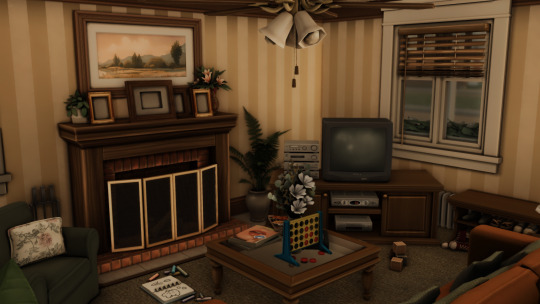



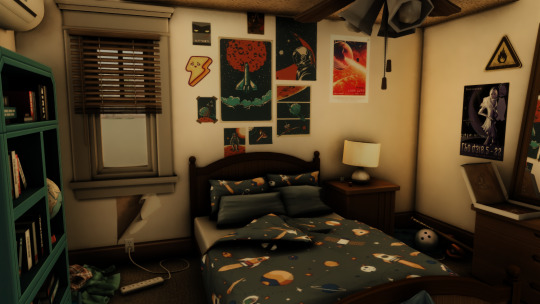
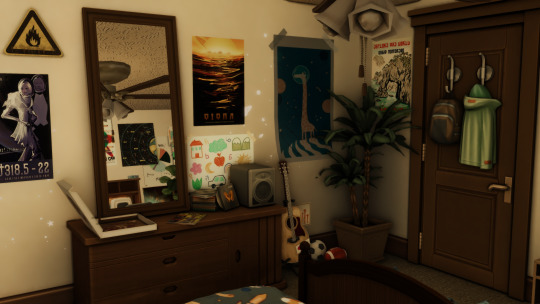
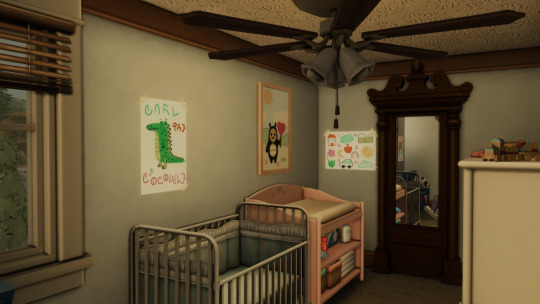







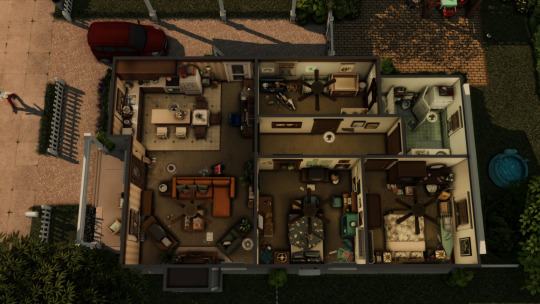

Early 2000s Home - Download Here
Hey everyone! I've been really inspired lately by the nostalgic aesthetic pioneered by @awingedllama and I wanted to create a small family home that is set in the early 2000s. It includes three bedrooms and a bathroom. One bedroom decorated for parents, one for a teen or child, and another for an infant.
I only chose appliances and electronics that would make sense for that time period. That means fat TVs, VCRs, old Mac computers, and CD players. I think my favorite part of the house is the carpet with all the stains lol.
This is the first home I'm releasing from a save file project I'm working on for Newcrest. No idea how long it will take but I'm just enjoying building what inspires me. This build includes tons of cc but I've gone very maxis match lately and have used a lot of maxis items that I previously would've ignored, opening up a lot of new ideas for me :). Stay tuned for more.
#showusyourbuilds#sims 4 build#sims 4 download#ts4 lot#ts4cc#simblr#sims 4#ts4#the sims 4#ts4 cc#simblog#ts4 custom content#sims4#s4 cc#ts4 download#comfy download
1K notes
·
View notes
Text
Fontaine Characters with Violinist Reader!
A/N: This disappearing thing of mine is annoying, I'm trying to stop it. However, I finally got a bit of spare time to play Genshin and I am so, so in love with Fontaine. I think it's gonna be a wonderful arc. I haven't felt this much jubilation since Liyue or Inazuma!
Warnings; None, really.
Lyney, Lynette, Neuvillette, Navia, Furina, Wriothesley (no particular order)
Lyney
First off, this boy is no stranger to performing, an activity he loves. Naturally, he's going to be most interested in fellow performers, including you!
If you're the type to get anxious before, or even during a performance, say goodbye to that with him. He'll guide you through plenty of destressing rituals to help you relax beforehand.
(This included, but wasn't limited to; Taking deep breaths, doing tongue twisters, asking you to play meme songs on your violin, or tickling your sides because 'laughing is a great way to be loose'.)
Even during, should you freeze up and he's in the audience, he'll do a quick but loud magic trick to get everyone's eyes off you. Even one that makes him look like a fool, so long as you have time to put yourself together.
He'd LOVE to have you on stage with him! He adores your music and would ask you to sync it up with dramatic moments in his magic.
If you compose you own stuff, he's pretty much your biggest fan. The guy who never misses a concert. The loudest clapper. The biggest braggart.
"That gorgeous, graceful violinist we had the pleasure of watching? What if I told you that they're coupled up with an equally electric performer? That is, me~."
Lynette
It's easy to think that her brother outdoes her in terms of being your fan, but quietness hides a lot. If you think she doesn't care as much, you're so, so wrong.
She learned several music skills just to be closer to you, including sight-reading. BTW, she's got a killer voice and loves to sing out your compositions. Sometimes it helps you come up with alternative movements within them.
She can also play piano, to a good level of accompaniment. With time, one would think she is also a music assistant; It's not uncommon for her to be on your stage.
Lynette is VERY attentive to your instrument. Does it need rosin? A new bow, perhaps a re-hair? You just say the word, and she'll happily take it to the repair workshop if you have no time.
"By the way, Y/N prefers real horse hair, the thinnest you have. Don't worry. They're talented enough to thrive on it.".
She makes it a point to let you know how much she loves what you do: "All other music in Fontaine pales in its beauty next to yours. Please, keep playing.".
Neuvillette
You play the violin? (he crosses his legs and assumes his royal position). So when are you going to get married? Will you be okay playing a few pieces, even while being the spouse? /Half-joking, tbh.
For him to say that he is the lover of a music pioneer as important as you... Will never not be a moment of joy for him.
First off, what a sugar daddy. I hope you made a list of the expensive violins you wanted but couldn't afford. Because now, it's yours, never mind the Mora. Your very case may as well be coated with gold.
He won't die on this hill, but he would love it if you could play a bit during the parties he hosts. He loves live music to begin with, but after hearing you, it feels like no other pro could hope to sound as good as you.
(And side note, he likes how mesmerized everyone is with you lol)
If you're the type to remember your patron's personal preferences, and compose/play in accordance to that, just for him? Put hearts in his eyes. He's no longer joking about the wedding thing.
While he loves showing you off, he'll never force you if you're shy/nervous. If anything, he would also feel very special if he got to heard songs not out yet, compositions just for him...
"Perhaps this is Lady Furina's way of rewarding me for my years of service. Bless our Archon for giving me such a talented, show and heart-stopping partner.".
Navia
She likes that the Spina del Rosula is represented by passionate, talented people!
If you like sweets, I say just join her team. It's guaranteed pastries after each request lol.
Her detective work is cool, but can get a bit drab after a while. She likes asking you to play some violin ambiance, partly because it makes her feel cool, and partly because your music changes the atmosphere for much better.
Navia is a woman of decorum, but she'll often have trouble staying still during your concerts. It doesn't matter if there are rules to how loud a woman can cheer, she's happy for you and will make sure you know that.
She becomes even more proactive than usual. If a concert of yours falls on the same time as her work, she'll scour the ends of Teyvat for its solution, so she can see you.
With time, she might request you to play pieces that her father loved. Once they're brought back to life, through your own strings, she can't help but be a little emotional. She must have done something wonderful to have you.
"How beautiful, how poignant as you, my dear Y/N! This calls for macaroons! Which flavor would you like today?".
Furina
"Yes, Neuvillette, I know they perform and all, but why can't I keep them to myself! They're so darn great, I want that everyday!"
Of course, she's not gonna stop you, but beware; I feel like Furina would almost turn you into her own personal violinist lol.
She'd keep requesting your presence over her other personal entertainment and somewhat bombard you with song requests. Buuut if you're looking for a varied repertoire, she's your gal!
One reason she requests so much is because she so impressed with how you not only fulfill them all, you do it so creatively and beautifully. You don't just follow the note as it is... Once you're acquainted with what she likes, you modify the tune a bit to be more her taste.
She's so cute when she claps; The way her hands go so fast and she's about to get up from the seat, the huge eye and smile... Why, you might start reconsidering her offer.
"Bravooooo, Y/N!! Bravo! That was everything, I can't go on without an encore!"
If the tune is more happy-go-lucky, she will get up and dance along. Will also do it in circles around you because she's your little orb :3
Wriothesley
"Forgive me for intruding... But I was overhearing, and your playing is terrific. Electrifying. Do you happen to perform on Saturday nights? That's when I can leave the Fortress for a bit.".
Of all your fans, Wrio is one of the quieter ones, but not so much that no one knows it. For one, he's a Duke, he's bound to enjoy good music. And heavens knows he needs some fun in his life.
Here's a fun thing (ngl this is what I was excited to write): At first, it doesn't sound like he can make it to your recital. You see him on his desk, surrounded by paper mountains that only ever seem to grow. He doesn't want to make you sad, but his remark lets you know that he's not coming: "Would it kill some of these people to tone it down for a bit so I can go see my partner perform?".
So imagine your shock when you step on stage, and see him on the first row, sitting tall and handsome, shit-eating grin on his face and waving. You really bought it for a moment.
"Hehe... Did you really think I can't even make a bit of time to see Fontaine's best violinist in action? You actually bought that?".
I HC that he has insomnia, and has tried any things to cure it, but to no avail. It's rumored in Fontaine that his is incurable, but little do they know about how he lays down next to your sitting form. Little do they know of the soft lullabies you composed just for him, or how peacefully he dreams afterwards 💜
#genshin impact x reader#genshin impact fontaine#lyney x reader#lynette x reader#furina x reader#neuvillette x reader#navia x reader#wriothesley x reader#genshin impact fanfics#genshin impact fluff
2K notes
·
View notes
Text
Mythology of Mrigashira nakshatra
Mrigashira's symbol is the Deer, which is associated with sensitivity, caution, and even skittishness - qualities typical of people born under the influence of this nakshatra.
The deer lives deep in the forest and is elusive. It has alert eyes and ears (i.e., well-developed senses). These traits may also be characteristic of Mrigashira individuals. Their sensitivity is very high, and if the Nakshatra is afflicted, it's crucial for them to learn how to calm and harmonize the mind.
Similar to deer, often searching for new pastures, Mrigashira people are pioneers and restless explorers, always in motion.
Mythologically, Mrigashira is ruled by Soma, the God of the Moon or the nectar of immortality and pleasure - something that one can never get enough of (there is always a desire for more). Mrigashira natives are drawn to liquids associated with pleasures. This may include wine, essential oils, perfumes, etc. Soma carries the hidden qualities of the Moon. Mrigashira individuals can be secretive. For example, if the ruler of the 11th house is in Mrigashira, they may have secret patrons or hidden friends. If the ruler of the 9th house is in this nakshatra, it can indicate hidden knowledge inaccessible to others. And since the goal of the nakshatra is moksha (liberation), this knowledge may become available to others after the person’s death (for example, through a book).
Another Mrigashira's trope is the image of the golden antelope - a symbol of prosperity and attachment to material wealth. It fulfils desires but does not bring happiness. Therefore, despite the natural shakti (power) of this nakshatra, people born under its influence often do not attain happiness, even if they possess what they desire. This is why, for example, if the ruler of the 7th house is in Mrigashira, there are often some issues in marriage (lack of happiness). Mrigashira people are different individuals before and after marriage - much like how deer grow antlers during mating season and shed them afterwards (so they change).
Additionally, there is a myth in which Brahma lusted after his daughter Saraswati, who fled from him by turning into a deer. Brahma chased after her. To protect her, God turned her into a nakshatra in the sky. This suggests that some improper (tamasic, sensual) desires remain unfulfilled.
The placement of Ketu in Mrigashira can indicate many unfulfilled desires, carried from past lifetimes (so in this lifetime, a native must resolve some karmic patterns from the past)

120 notes
·
View notes
Text
"Justine Siegal, the first woman coach employed by a Major League Baseball team, is attempting to make more history -- this time by creating an American professional baseball league specifically for women. Siegal is one of the co-founders of the Women's Pro Baseball League (WPBL), which aims to begin play during the summer of 2026.
Siegel and co-founder/lawyer Keith Stein have enlisted a few other notable names as special advisors... Those include World Series-winning manager Cito Gaston and Japanese pitcher Ayami Sato, a five-time Women's Baseball World Cup champion. (Sato is also part of Japan Women's Baseball League.)
The WPBL is hoping to land a national television deal ahead of its inaugural season. The league intends to have a full season, as well as playoffs and a championship round. At present, the goal is to field six teams at launch, with those clubs located "predominantly" in the Northeast region of the United States.
"The Women's Pro Baseball League is here for all the girls and women who dream of a place to showcase their talents and play the game they love," Siegal said as part of the WPBL's press release announcing its formation. "We have been waiting over 70 years for a professional baseball league we can call our own. Our time is now."
Stein, for his part, added: "We believe that the success of other women's professional leagues such as the WNBA and NWSL demonstrates the incredible interest and support for women's sport."
The United States has won two Women's Baseball World Cups, and most recently finished as the runners-up in the 2024 event (that was played in 2023). The U.S. team roster included, among others, pitcher/outfielder Kelsie Whitmore. Whitmore has been a trailblazer in her own right, appearing in games with various independent leagues, including the Atlantic League, Pacific Association, and, as of this year, the Pioneer League."
-via CBS Sports, October 30, 2024
#baseball#mlb#wpbl#women's sports#feminism#women's baseball#a league of our own#I know it's not about the movie but I'm tagging anyway#united states#good news#hope
512 notes
·
View notes
Note
Hi, so i writing a book based in the 1800s like the cowboy eras can you please tell me somethings I should keep in mind about the society and stuff also I need a little motivation I have been loosing it all please and thankyou <<<333
Writing Notes: Cowboys
Cowboy
In the western United States: a horseman skilled at handling cattle, an indispensable laborer in the cattle industry of the trans-Mississippi west, and a romantic figure in American folklore.
Pioneers from the United States encountered Mexican vaqueros (Spanish, literally, “cowboys”; English “buckaroos”) on ranches in Texas about 1820, and soon adopted their masterful skills and equipment—the use of lariat, saddle, spurs, and branding iron.
But cattle were only a small part of the economy of Texas until after the Civil War.
The development of a profitable market for beef in northern cities after 1865 prompted many Texans, including many formerly enslaved African Americans, to go into cattle raising. (Though they have been almost entirely excluded from the mythology of the American cowboy, it is estimated that Black cowboys accounted for nearly a quarter of all cattle workers in the nascent American West during the latter half of the 19th century.)
By the late 1800s, the lucrative cattle industry had spread across the Great Plains from Texas to Canada and westward to the Rocky Mountains.
Vaqueros
In 1519, shortly after the Spanish arrived in the Americas, they began to build ranches to raise cattle and other livestock. Horses were imported from Spain and put to work on the ranches.
Mexico’s native cowboys were called vaqueros, which comes from the Spanish word vaca (cow). Vaqueros were hired by ranchers to tend to the livestock and were known for their superior roping, riding and herding skills.
By the early 1700s, ranching made its way to present-day Texas, New Mexico, Arizona and as far south as Argentina. When the California missions started in 1769, livestock practices were introduced to more areas in the West.
During the early 1800s, many English-speaking settlers migrated to the West and adopted aspects of the vaquero culture, including their clothing style and cattle-driving methods.
Cowboys came from diverse backgrounds and included African-Americans, Native Americans, Mexicans and settlers from the eastern United States and Europe.
Cowboy Life
Cowboys were mostly young men who needed cash. The average cowboy in the West made about $25 to $40 a month.
In addition to herding cattle, they also helped care for horses, repaired fences and buildings, worked cattle drives and in some cases helped establish frontier towns.
Cowboys occasionally developed a bad reputation for being lawless, and some were banned from certain establishments.
They typically wore large hats with wide brims to protect them from the sun, boots to help them ride horses and bandanas to guard them from dust. Some wore chaps on the outsides of their trousers to protect their legs from sharp cactus needles and rocky terrain.
When they lived on a ranch, they shared a bunkhouse with each other. For entertainment, some sang songs, played the guitar or harmonica & wrote poetry.
Cowboys were referred to as cowpokes, buckaroos, cowhands and cowpunchers.
The most experienced cowboy was called the Segundo (Spanish for “second”) and rode squarely with the trail boss.
Everyday work was difficult and laborious for cowboys. Workdays lasted about 15 hours, and much of that time was spent on a horse or doing other physical labor.
Rodeo Cowboys
Some cowboys tested their skills against one another by performing in rodeos—competitions that were based on the daily tasks of a cowboy.
Rodeo activities included bull riding, calf roping, steer wrestling, bareback bronco riding and barrel racing.
The first professional rodeo was held in Prescott, Arizona, in 1888. Since then, rodeos became—and continue to be—popular entertainment events in the United States, Mexico and elsewhere.
Joseph G. McCoy offered the wealthy cattleman's vision of the cowboy. He recorded a reasonably balanced, if slightly condescending, views in his 1874 treatise on the cattle trade.
He lives hard, works hard, has but few comforts and fewer necessities. He has but little, if any, taste for reading. He enjoys a coarse practical joke or a smutty story; loves danger but abhors labor of the common kind; never tires riding, never wants to walk, no matter how short the distance he desires to go. He would rather fight with pistols than pray; loves tobacco, liquor and women better than any other trinity. His life borders nearly upon that of an Indian. If he reads anything, it is in most cases a blood and thunder story of a sensational style. He enjoys his pipe, and relishes a practical joke on his comrades, or a corrupt tale, wherein abounds much vulgarity and animal propensity.
Black Cowboys
African American horsemen who wrangled cattle in the western United States in the late 1800s and beyond.
Though they were almost entirely excluded from the mythology of the American cowboy, it is estimated that Black men accounted for nearly a quarter of all cattle workers in the nascent American West during the latter half of the 19th century.
In the years following the Civil War (1861–65) and emancipation from slavery, a budding ranching industry promised freedom and prosperity unknown to most Black Americans, many of whom were formerly enslaved themselves or were the children of enslaved parents.
Texas became part of the United States in 1845, and, by 1860, enslaved people accounted for 30 percent of the state’s population. Among them were some of the first Black cowboys: skilled laborers with experience in breaking horses and herding stock. Many were given the autonomy to work unsupervised, and some even carried guns.
The cowboy lifestyle came into its own in Texas, which had been cattle country since it was colonized by Spain in the 1500s. But cattle farming did not become the bountiful economic and cultural phenomenon recognized today until the late 1800s, when millions of cattle grazed in Texas.
White Americans seeking cheap land—and sometimes evading debt in the United States—began moving to the Spanish (and, later, Mexican) territory of Texas during the first half of the 19th century.
Though the Mexican government opposed slavery, Americans brought slaves with them as they settled the frontier and established cotton farms and cattle ranches.
By 1825, slaves accounted for nearly 25 percent of the Texas settler population.
By 1860, fifteen years after it became part of the Union, that number had risen to over 30 percent—that year’s census reported 182,566 slaves living in Texas.
As an increasingly significant new slave state, Texas joined the Confederacy in 1861. Though the Civil War hardly reached Texas soil, many white Texans took up arms to fight alongside their brethren in the East.
While Texas ranchers fought in the war, they depended on their slaves to maintain their land and cattle herds.
In doing so, the slaves developed the skills of cattle tending (breaking horses, pulling calves out of mud and releasing longhorns caught in the brush, to name a few) that would render them invaluable to the Texas cattle industry in the post-war era. But with a combination of a lack of effective containment— barbed wire was not yet invented—and too few cowhands, the cattle population ran wild.
Ranchers returning from the war discovered that their herds were lost or out of control. They tried to round up the cattle and rebuild their herds with slave labor, but eventually the Emancipation Proclamation left them without the free workers on which they were so dependent.
Desperate for help rounding up maverick cattle, ranchers were compelled to hire now-free, skilled African-Americans as paid cowhands.
Freed blacks skilled in herding cattle found themselves in even greater demand when ranchers began selling their livestock in northern states, where beef was nearly ten times more valuable than it was in cattle-inundated Texas.
The lack of significant railroads in the state meant that enormous herds of cattle needed to be physically moved to shipping points in Kansas, Colorado and Missouri. Rounding up herds on horseback, cowboys traversed unforgiving trails fraught with harsh environmental conditions and attacks from Native Americans defending their lands.
African-American cowboys faced discrimination in the towns they passed through—they were barred from eating at certain restaurants or staying in certain hotels, for example—but within their crews, they found respect and a level of equality unknown to other African-Americans of the era.
Sources: 1 2 3 4 5 ⚜ More: Notes & References ⚜ Writing Resources PDFs
Writing occasionally makes me feel like I'm losing it too! I find that taking a step back can be good. That time away from being a writer can be used to being the reader again, and to research your topic. And when your head's clear enough, you can go back & see if the story flows more freely, armed with information you collected to incorporate in your writing. Hope this helps <3
#cowboy#character development#writeblr#spilled ink#dark academia#writing tips#writing advice#history#character building#fiction#writing inspiration#writing ideas#light academia#literature#writers on tumblr#poets on tumblr#writing prompt#writing reference#creative writing#writing resources
200 notes
·
View notes
Text
Katherine Johnson: The Mathematician Who Launched Astronauts into Space and Women into STEM 🚀👩🚀
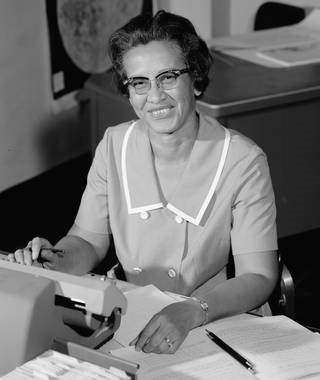
In the vast expanse of the cosmos, where men first dreamed of reaching the stars, Katherine Johnson calculated the path that would get them there. This story isn't just about trajectories and orbits; it's about a woman whose brilliance in mathematics helped break the barriers of space and gender.

Johnson's journey began in White Sulphur Springs, West Virginia, where her curiosity and intelligence shone from an early age. Despite encountering segregation and sexism, she charted a course that would lead her to NASA, where her skills became indispensable to the success of the U.S. space program. Her calculations were critical to the success of the Mercury missions, including John Glenn's pioneering orbital flight, for which he specifically requested Johnson verify the computer's numbers. "If she says they're good," Glenn said, "then I'm ready to go."

But Johnson's contributions went beyond Mercury. She also played a role in the Apollo missions, including the first lunar landing, and her work on orbital mechanics laid the groundwork for the Space Shuttle program and plans for a Mars mission.

Her legacy is a beacon for women and people of color in STEM, symbolizing the power of intelligence and perseverance to overcome societal constraints. Johnson's story teaches us that the path to the stars is paved with determination, hard work, and an unwavering belief in one's own abilities.

Katherine Johnson's calculations helped lead humanity to the moon, but her impact extends far beyond the numbers. She charted a course for future generations of women in STEM, proving that the sky is not the limit—it's just the beginning. As we look up at the stars, we remember her legacy, not just as a mathematician, but as a trailblazer who launched us into a new era of exploration and equality.
#PiDay#KatherineJohnson#Katherine Johnson#NASA#Mathematics#National Archives#Women's History Month#HERstory#Archives#Apollo13#Mercury#STEM#Women in STEM#Science
618 notes
·
View notes
Text


Edmund White, who became a pioneer in gay literature by mining his own varied catalog of sexual experiences in more than 30 books and hundreds of articles and essays, died on Tuesday at his home in Manhattan. He was 85.
For several decades, Mr. White’s therapists, with his encouragement, tried to “cure” him of homosexuality, which at the time was considered a mental illness. A more successful form of therapy was writing, he said. Writing, he told The Sydney Morning Herald in 2006, “has always been my recourse when I’ve tried to make sense of my experience or when it’s been very painful.”
Mr. White’s output was almost equally divided between fiction and nonfiction. Many of his books were critical successes, and several were best-sellers. The Chicago Tribune labeled him “the godfather of queer lit.”
He was a star almost from the beginning. The New York Times called Forgetting Elena (1973), about the rituals of gay life on a fictionalized Fire Island, “an astonishing first novel, obsessively fussy, and yet uncannily beautiful.” His second novel, Nocturnes for the King of Naples (1978), took the form of letters from a young gay man to his deceased ex-lover.
A Boy’s Own Story (1982), a tale of coming out set in the 1950s, was narrated by a teenager who bore more than a passing resemblance to a young Mr. White. His other semi-autobiographical novels, The Beautiful Room Is Empty (1988) and The Farewell Symphony (1997), follow the same unnamed protagonist into adulthood during the 1960s, then through the horrors of AIDS as he approaches middle age.
He was one of seven members of The Violet Quill, a gay writers’ group founded in 1979 that included the soon-to-be celebrated authors Andrew Holleran and Felice Picano. The members met regularly to critique one another’s work. In 1982, he helped found the group Gay Men’s Health Crisis in New York City.
His nonfiction works included a number of memoirs. My Lives (2005), one of his best-reviewed books, chronicles his first 65 years with chapter titles that include “My Shrinks, “My Hustlers” and “My Blonds.” He zeroed in on his life in 1960s and ’70s New York with City Boy (2009), and on his life away from New York with Inside a Pearl: My Years in Paris (2014).
The Joy of Gay Sex (1977), a how-to based on the 1972 best seller The Joy of Sex, was a groundbreaking effort that became somewhat obsolete once fears of H.I.V. made safe sex far more common. Its co-author was Charles Silverstein, a therapist who had been treating Mr. White until a publisher suggested that they collaborate, not knowing they were already well acquainted.
His nonfiction works also include biographies of the French authors Jean Genet, Marcel Proust and Arthur Rimbaud.
While some of his peers tried to separate their sexuality from their work, Mr. White embraced the term “gay writer.” As he explained in City Boy, “If I’d been straight, I would have been an entirely different person. I would never have turned toward writing with a burning desire to confess, to understand, to justify myself in the eyes of others.”
His life provided ample material for the prolific writer he was. “White has accumulated enough sexual partners,” Peter Conrad wrote in The Guardian in 2005, “to fill the telephone directory of a moderate-sized city.”
In 1995, he began a relationship with Michael Carroll, a writer 25 years his junior. The men lived together in the Chelsea neighborhood of Manhattan and married in 2013. But Mr. White had no intention of being monogamous. In 2006, he told The Sydney Morning Herald that their relationship “is probably like an 18th-century marriage in France.”
In addition to his husband, he is survived by his sister, Margaret.
(Full article)

#edmund white#literature#lit#gay literature#lgbt literature#lgbtq literature#history#gay history#lgbt history#lgbtq history#gay#lgbt#lgbtq#lgbtqia#bookblr#2020s
127 notes
·
View notes